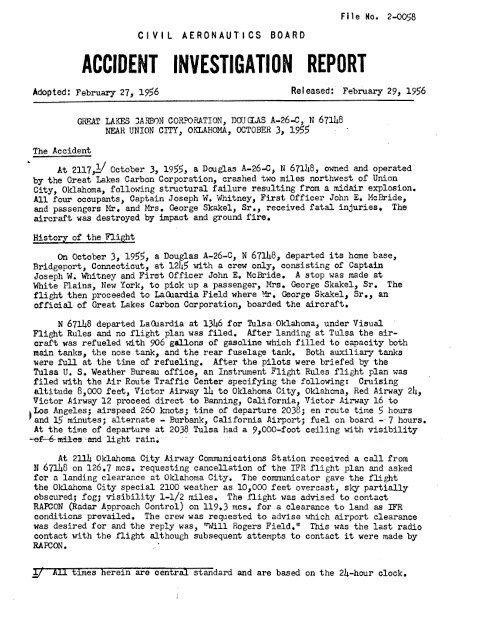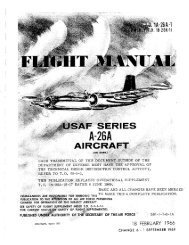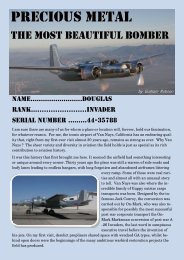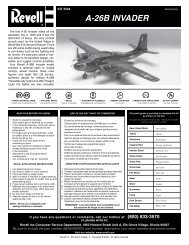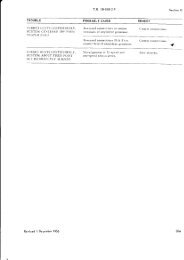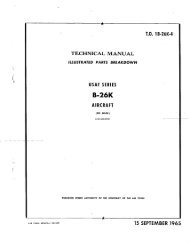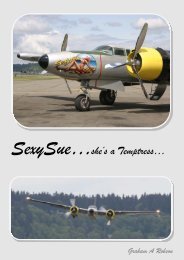44-35950 Oct 3, 1955 Air accident report - The Douglas A-26 Invader
44-35950 Oct 3, 1955 Air accident report - The Douglas A-26 Invader
44-35950 Oct 3, 1955 Air accident report - The Douglas A-26 Invader
You also want an ePaper? Increase the reach of your titles
YUMPU automatically turns print PDFs into web optimized ePapers that Google loves.
CIVIL AERONAUTICS BOARD<br />
File No. 2-0058<br />
Adopted: February 27, 19% Released: February 29, 1956<br />
GRFAT LAKE3 ZAAWrlN CORWRATION, MIUCLAS A-<strong>26</strong>4, N 67148<br />
NEAR UNION CITY, OKLAHOMA, OCTOBER 3, <strong>1955</strong><br />
<strong>The</strong> Accident<br />
.<br />
At 2117,11 <strong>Oct</strong>ober 3, <strong>1955</strong>, a <strong>Douglas</strong> A-<strong>26</strong>4, N 6711r8, owned and operated<br />
by the Great Lakes Carbon Corporation, crashed two miles northwest of Union<br />
City, Oklahoma, following structural failure resulting from a midair explosion.<br />
All four occupants, Captain Joseph W. Whitney, First Officer John E. McBri.de,<br />
and passengers Plr. and Mrs. George Skakel, Sr., received fatal injuries. <strong>The</strong><br />
aircraft was destroyed by impact and ground fire.<br />
History of the Flight<br />
On <strong>Oct</strong>ober 3, <strong>1955</strong>, a <strong>Douglas</strong> A-<strong>26</strong>-C, N 67l.48, departed its home base,<br />
Bridgeport, Connecticut, at 1245 with a crew only, consisting of Captain<br />
Joseph W. Whitney and First Officer John E. McEkide. A stop was made at<br />
White Rains, New York, to pick up a passenger, Mrs. George Skakel, Sr. <strong>The</strong><br />
flight then proceeded to LaQlardia Field where ?fro George Skakel, Sr., an<br />
official. of Great Lakes Carbon Corporation, boarded the aircraft.<br />
N 67148 departed LaCbardia at 1346 for Tulsa Oklahoma, under Visual.<br />
Flight Rules and no flight plan was filed. After landing at Tulsa the aircraft<br />
was refueled with 906 gallons of gasoline which filled to capacity both<br />
main tanks, the nose tank, and the rear fuselage tank. Both auxiliary tanks<br />
wsre full at the time of refueling. After the pilots were briefed by the<br />
Tulsa IJ. S. Weather Bureau office, an Instrument Flight Rules flight plan was<br />
filed with the <strong>Air</strong> Route Traffic Center specifying the following: Cruising<br />
altitude 8,000 feet, Victor <strong>Air</strong>way 14 to Oklahoma City, Oklahorna, Red <strong>Air</strong>way 24,<br />
Victor <strong>Air</strong>way 12 proceed direct to Banning, California, Victor <strong>Air</strong>way 16 to<br />
Los Angeles; airspeed <strong>26</strong>0 knots; time of departure 2033; en route time 5 hours<br />
land 15 minutes; alternzte - Burbank, California <strong>Air</strong>port; fuel on board - 7 hours.<br />
At the time of departure at 2038 Tulsa had a 9,000-foot ceiling with visibility<br />
=&--6miles and light rairi.<br />
At 2U.4 Oklahoma City <strong>Air</strong>way Communications Station received a call from<br />
N 67aB on 1<strong>26</strong>.7 mcs. requesting cancellation of the IFF? flight plan and asked<br />
for a landing clearance at Oklahoma City. <strong>The</strong> communicator gave the flight<br />
the Oklahoma City special 2100 weather as 10,000 feet overcast, sky partially<br />
obscured; fog; visibility 1-1/2 miles. <strong>The</strong> flight was advised to contact<br />
RAFCON (Radar Approach Control) on 119.3 mcs. for a clearance to land as IFR<br />
conditions prevailed. <strong>The</strong> crew was requested to advise which airport clearance<br />
was desired for and the reply was, 'Will Rogers Field." This was the last radio<br />
contact with the flight a3though subsequent attempts to contact it were made by<br />
RAPCON .<br />
All times herein are central standard and are based on the 24-hmr clock.
- 2 -<br />
/<br />
At ap;oroxjmately 2117 an aircraft, later identified as N 67148, was<br />
observed to crxh on a fm. 2-3/8 miles northwest of Union City, Oklahoma,<br />
and 33 miles west of Will Rogers Field, Oklahoma City, Two explosions were<br />
heard in the air prior to the crash and portions of the empennage and fuse-<br />
lage were fomd along the last three miles of the fl!.ght path.<br />
Imresti gation<br />
Witnesses several miles north of the crash site, who observed %he eircraft<br />
several hvndred feet above the ground, describe two distinct flashes<br />
in its descent to the ground. <strong>The</strong>y also mention a 1jgh.t rain at the time<br />
but no li@tning.<br />
Examination of the wreck?.ge and ground marks indicated that the aircrsft,<br />
minus the aft fuselage a d tail ascembly, had dived to the ground, in an<br />
inverted attitude at nose-down angle of approximately 45 degrees on a south-<br />
east erly herding.<br />
Disintegratjon in flj.ght was 5ndicated by nuneras aegnents of the fuselage<br />
shell and portions of the horizontal stabilizer sk5.n being found back<br />
along the fli..ght. path as far as three riles from the main wreckage, <strong>The</strong> main<br />
portion of the empennage was found three-eighths of a mile from the main<br />
wreckage, All of the sccttered portions of fuselage structure were from the<br />
area aft of the cabin rear bi.ilkhead,<br />
Ekminatton of these parts gave evidence of internal explosive forces that<br />
had blcwn the skin outwexl or off and distorted the structure of all empennage<br />
components except the rudder a d the elevators, <strong>The</strong>re were no indicstions of<br />
heat damage or fatigue in the zft fuselcge wreckae which could have result,ed<br />
in failure under loads less than design. <strong>The</strong>re was no compression buckling of<br />
the skin and stringers, characteristic of failwes due to overload, However,<br />
there were numeroils indications of the ?ft fuselage shell having disintegrated<br />
because of excessive tensile stresses throughout the entire shell acting both<br />
longitudinally and peripherally at the same time, <strong>The</strong> fxselage disintegrated<br />
along rivet seams, which are areas of least tensjle strength, evidencing a<br />
practj.cally uniform internal pressure throughout the aft portion of the fuselege.<br />
<strong>The</strong> aircraft was not equipped for cabin nressurizatSon,<br />
No evidencs was disclosed to suggest fzilure or mlfunctioning of the<br />
engines or propellers prior to impact.<br />
&amination revealed scorched edges at the torn holes in the rudder<br />
fabric, Blistered paint was likewise noted at the trailing edge of the left<br />
elevator. <strong>The</strong> source of this flame damage was not associated with the ground<br />
fire.<br />
Destruction of the aircraft forward of the cabin aft bulkhead by ground<br />
fire was extensive. Major components, including wings, flaps, ailerons, nose<br />
and cockpit areas, controls, instruments, fuel tanks landing gear, nacelles,<br />
etc., were all accounted for in the area adjacent to the point of impact.<br />
Exaxination disclosed that the wing flaps and the landing gear were in the<br />
retracted position at the time of impact.<br />
I ,I
-3-<br />
Only the following instrument readings were obtainable: Omni Bearing<br />
Selector 232 degrees; Radio Magnetic Indicator - double pointer 240 degrees,<br />
single pointer (ADF) 198 degrees; Zero Reader Selector 240 degrees; C2 Gyro<br />
Compass 246 degrees,<br />
A 125-gallon fuel tank and radio rack were installed in the aft fuselage<br />
without a vapor seal separating the two units. <strong>The</strong> severe fire damage after<br />
ground impact precluded a determination of the condition of the fuel system<br />
components prior to the <strong>accident</strong>. <strong>The</strong> aft fuselage fuel tank vent line was<br />
found with its end fittings failed from excessive tension. It was established<br />
that the aft f'uselage tank was filled to capacity at the time of departure from<br />
Tulsa. <strong>The</strong> 'hlsa fuel attendant stated the tank was not overfilled at the time<br />
,of servicing.<br />
I<br />
In the tail section of the fuselage, aft of the rear cabin bulkhead, in<br />
addition to the 125-gallon fuel tank, there was installed the followring elec-<br />
trical equipment: (2) ARN-7 compass; (2) loop anterma; (1) MN53B merker<br />
receiver; (1) ARNSA glide path receiver; (1) RTA-1B cormand unit; (1) 8-12<br />
gyro.syn repeater amplifier; (2) ColJ-ins SIR, (2) Collins l?L-ZtTHF transmitter;<br />
(2) inverters; (I.) isolation amplifier; (1) R-89B glide path and (1) E733<br />
localizer,<br />
A study of the aircraft records revealed no pertinent. discrepzncies. <strong>The</strong><br />
most recent airframe LOO-hour inspection was dated September 8, <strong>1955</strong>, and the<br />
aircraft had flown 114 hours since that time. This inspection covered the<br />
security of the interior equipment, such as tank, radio, all lines, cables, and<br />
A42 servos of the enpennage and tail compartment. <strong>The</strong> last line inspection<br />
(at LaChardia on <strong>Oct</strong>ober 3, <strong>1955</strong>) revealed no discrepancies,<br />
After the <strong>accident</strong> a flight check of the ground nsvigationa facilities<br />
involved in an approach to Oklahoma Ci-ty disclosed normal. operation of all<br />
wAts,<br />
Aero Trades, Inc., CAA Approved Repair Station No. 115, ElacArthur <strong>Air</strong>port,<br />
Rotilconkoma, New York, modified the aircraft for passenger ca.rq6.n~. <strong>The</strong> aircraft<br />
was then certificated by the Civil Aeronautics AMnistratton in the<br />
limited category which prohibits the carrying of passengers for hire. <strong>The</strong>ir<br />
work accomplished in accordance with Foms ACA 337 (CAA Repair and Alteration<br />
Formj dated April 4, 1951, and April 9, 1951, included the following item:<br />
)No. 15. Installed Ann type 125-gallon fuel tank in aft section of fuselage<br />
(original installation 5 .<br />
According to records of the &e2t Lakes Carbon Corporation Aviation Depmt-<br />
ment, all <strong>Air</strong> Force Technical Orders for the A0<strong>26</strong> had been rece5ved and compli-<br />
ance had been accomplished.<br />
Analysis<br />
Facts determined by investigation disclosed that the tail surfaces and<br />
fuselage aft of the bulkhead at the rear end of the cabin separated from the<br />
airplane in flight,<br />
\
-4-<br />
<strong>The</strong> manner in which the skin bulged ovtward and separated from the hori-<br />
zontal stabilizers and bulged outward on the fin could result only from very<br />
high internal pressures. It is apparent that the pressures which caused the<br />
disintegration built up suddenly and that they originated in the aft fuselage.<br />
Only an explosion within the aft fuselage could cmse a sudden pressure increase<br />
of this nature,<br />
Ebcplosions from concentrated sources, such as sticks of dynamite or containers<br />
of TNT, produce severe shattering and fragment?-tion close to the source<br />
of explosion with decreasing fragmentation as distance from the source increases.<br />
This tspe of explosion also leaves soot-like deposits on the structure shattered,<br />
Neither of these characteristics was present in this case. Instead, the fhselage<br />
disintegration indicated a practically uniform pressure such as is caused ,<br />
by the ignition of an air-gasoline mixture which js much slower than the detonation<br />
of hi& explosives. In eddition, this latter type of explosion does not<br />
leave deposits on the structure,<br />
<strong>The</strong> Board therefore concludes that fmes<br />
caused by leaking fuel were ignited by operation of electrical equipment.-installed<br />
in the aft fuselage.<br />
<strong>The</strong> scorched fabric and blistered paint on the tail control surfapes appetw<br />
to have been caused by momentary hrning of fuel which spurted out of the aft<br />
fuselage tank after the first explosion disrupted the fuel lines. This fuel<br />
drenched the tail surfaces while the tail assexbly was still attached to the<br />
main part of the aircraft by rneans of control cables.<br />
This same fuel was<br />
probably ignited by sparks from disrupted wires of the electrical equipnent in<br />
the aft fuselage which cmld well account for the seccnd explosion described<br />
by ground witnesses.<br />
<strong>The</strong> nature of the <strong>accident</strong> and the fact that all pomnications from the<br />
flight were routine and conducted in a normal tone of voice indicate that the<br />
pilots were unaware of an immediate emergency. <strong>The</strong> re8son for discontinuing<br />
the .fll?ht to California. and the decision to land at Oklahoma City coulc! not be<br />
determined.<br />
As a result of tne investigation the Eoard reconmended to the Civil Aeronautics<br />
Administration that all owners and operators of A-<strong>26</strong>-B and A-<strong>26</strong>4<br />
aircraft be immediately advised of the possible fire and explosion hazards<br />
inherent in similar installations and that corrective ection be taken immediately.<br />
Accordingly, the f o?-lowing notification was f omard.ed to all Aviation<br />
Safety District Offices, apd to all owners of this model aircraft: "Investigation<br />
recent Ad6 acciclent indicates possible fire and explosion hazard in<br />
-rear-=fuseIage area. For a91 A-<strong>26</strong>-B and A-<strong>26</strong>-C; aircraft having rear fuselage<br />
tank installed in szqe coqm-hefit with electrical components liable to sparking<br />
the following restriction is mandatory until further notice: Rear fuselage fie1<br />
tank shall be drained, purged, and marked to prohibit use. Placard cockpit fuel<br />
controls and filler cap for information pilot and servicing personnel."<br />
??lis<br />
notice was followed by AD 55-<strong>26</strong>-1 which s,pecifies modifications for reactivation<br />
of the rear fuselage tank.<br />
e. the Oasis of al? available evidence the Board finds that:<br />
1. Both pilots and the aircraft were currently certific2.ted.
2. <strong>The</strong> load of the aircraft was within gross weight limits and was<br />
properly distributed,<br />
3. Weather was not a factor in the <strong>accident</strong>.<br />
4. <strong>The</strong>re was no evidence to indicate failure or malfunctioning of the<br />
engines or propellers.<br />
5. Both a fuel tank and miscellaneous electric33 equlpent were installed<br />
in the aft fuselage.<br />
6. <strong>The</strong> aft fusehge tank was dilled to capacity shortly before the<br />
<strong>accident</strong><br />
7. <strong>The</strong> fuel system components in the aft fuselage were not separated<br />
adequately from the electrical equipment by a fume-tight seal.<br />
8. Fumes from gasoline in the sft fuselage pervaded the interior of the<br />
horizontal stabilizer and vertical fin.<br />
9. <strong>The</strong> inflight ignition of the explosive fuel-air mixture and resultant<br />
pressure surge in the aft fuselage caused structura fzilure.<br />
10. Following the <strong>accident</strong> immediate corrective action was taken by the<br />
Civil Aeronautics Board and Civil Aeronautics Adqinistration.<br />
Probable Cause<br />
<strong>The</strong> Board determines that the probable cause of this mcident w2.s the<br />
loss of the aircraft’s empennage as a result of an inflight fuel explosion<br />
in the aft section of the fwelage.<br />
BY THE CIVIL AEP,Ol\rAVJ!ICS ROARnr<br />
/s/ ROSS RIZLM
Investigation<br />
<strong>The</strong> Civil Aeronautics Board was notified of this <strong>accident</strong> at 0700<br />
<strong>Oct</strong>ober i4, <strong>1955</strong>. An investigation was immedictely started. in accordance<br />
with the provisions of Section 702 (a) (2) of the Civil Aeronaztics Act<br />
of 1936, I I as amended,<br />
<strong>Air</strong>crdt Operator<br />
<strong>The</strong> Great Lakes Carbon Corporation, 18 East b8th Street, New York, New<br />
Pork, purchased their fjrst aircraft in 19L16. <strong>The</strong>y presently ovm and operate,<br />
in addition to the subject 4.0<strong>26</strong>, two <strong>Douglas</strong> DC-Ys and two Cessna 180's.<br />
<strong>The</strong>se aircraft, used to transport company personnel to numerous points in the<br />
I!ni.ted States, Canada, Mexico, end the Caribbean area flew a total of 10,797<br />
hours from 1946 to <strong>1955</strong>.<br />
Fli eht Personnel<br />
Captain. Joseph trlarren Whitney, age 34, held a currently effective airline<br />
transport pilot certificate with an appropriate rating for the subject aircraft,<br />
He wes employed as a captain Jcly <strong>26</strong>, 1952* Captain Whitney had accumulated<br />
approximately 11,500 pilot huurs, of which 900 were in A-<strong>26</strong> type aircraft. His<br />
lest physEcd examination was on Septenber 30, <strong>1955</strong>. He pessed a captain's<br />
and m instrument check on September 2?, <strong>1955</strong>.<br />
First Officer John E, McBri.de, age 31, held a currently effective airljne<br />
transport pilot ccrtificcte with zppropriate rctings. He was employed t,empo-<br />
rarily for swy days in 1953, and permanently- by the company on April 1, 19SS.<br />
I*. McBr5.de had accumulated approximately 2,5<strong>44</strong> pilot hours, of which approx-<br />
imately 500 were in the type equipment involved. He passed his last physical.<br />
exmination in April <strong>1955</strong> and his last instrument check on September 29, <strong>1955</strong>.<br />
<strong>The</strong> Aj-rcraft<br />
<strong>The</strong> <strong>Douglas</strong> A-<strong>26</strong>4 (limited), N 67148, bore mmufacturer's serial number<br />
29229 and was built in 1945 for the U. S. <strong>Air</strong> Force, It was purchased by Great<br />
Lakes Carbon Corporation July <strong>26</strong>, 1950, and modified for passenger carrying in<br />
April l?sl, Tots airfrane time as of September 28, <strong>1955</strong>, was 2,183 hours with<br />
3.4 hours since the last 100-hovr inspection.<br />
<strong>The</strong> aircraft; was equipped with<br />
Pratt and Whitney model R-2800-27ML engines and Haalton Standzrd model 23EsO<br />
propellers. Time on the engines and propellers since overhaul was 122 hours.<br />
Time on the engines since the last 100-hour inspection on August 11, <strong>1955</strong>, was<br />
48 hours ,<br />
i


